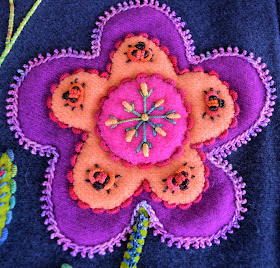Block 10 is the final block of Nocturne's garden. The embellishment includes stitches you've used on previous blocks but there is a little "tweaking" required.
First, sew the side seams of Block 9 and 10 together, with Block 9 on the left side. Press the seams open.
Oops, the flower center is missing! Draw the missing part in as shown on the red line:
Sorry about that!
Draw in a line for the lavender stem with a chalk pencil. Remember to begin stitching the Bullions at the top of the stem, working down one side and then repeat for the other side to minimize wasting thread on the back.
Sew all of the blocks together by machine with a 1/4" seam allowance and press the seams open. As mentioned before, use plenty of pins to hold the blocks in place for sewing to avoid stretching the wool. If your sewing machine has a walking foot, use it to make this step even easier. I also recommend using a Strip Stick when pressing the seams to avoid crushing your embroidery.
Press the center seam very well to make it as smooth as possible and avoid "lumps" showing through the tree trunk.
Block 11 - Tree Trunk
Trace the sections of the tree trunk on the template page to a long piece of freezer paper and cut out on the drawn lines. Lay this freezer paper template over the center seam and make any needed adjustments to the trunk before ironing onto the wool. Remember, there is a leaf at the top of the tree, shown on the template pages for Blocks 1 and 2.
Pin the tree trunk in place and applique as you have the other blocks. I found this was much easier to do with the quilt laying flat on a table. Applique the top leaf in place and embellish using the same thread and stitches as for the leaves on Blocks 1 and 2.
I did a Back Stitch around the tree trunk, and asked my machine quilter, Cindy Paulson, www.quiltedconnection.com to add quilting in the trunk.
Here is a short video of How to Stitch the Tree Trunk
Nocturne
A Magical Nighttime Garden
Congratulations on finishing this project. If you haven't already joined my Facebook group, Kerry's Crazy for Embellishment, please join today, post photos of your progress, and keep posted on my next design coming in Spring 2020.



















































